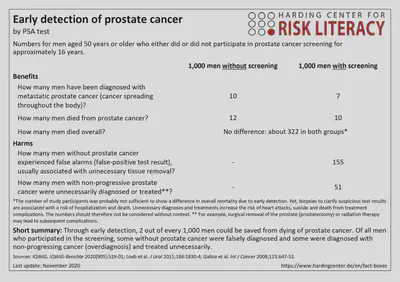Fact boxes: Concisely summarizing the best available evidence
What is the boost?
A fact box is a tabular summary of the best available evidence about the benefits and harms of a medical procedure, medical treatment, or health behavior (see McDowell et al., 2016, for a guide for creating a fact box).

This is a fact box for PSA screening as a tool for early detection of prostate cancer. Information about the benefits and harms of screening are presented side by side, making it easy to compare outcomes between men who were screened and men who were not. Information about risks is summarized in absolute numbers so that people can weigh the benefits against the harms. Other features include a short summary; the reference class, age range, and time frame of the study; and any caveats that may influence how people interpret the evidence.
Which challenges does the boost tackle?
Representations of statistical information that are incomplete (e.g., excluding benefits, harms, or the base rate), unbalanced (e.g., emphasizing either benefits or harms), or opaque (e.g., presenting risks in relative numbers) can lead to poor understanding of risks and thus to poor decisions.
Which competences does the boost foster?
Risk literacy: the competence to understand and assess statistical information about risks.
What is the evidence behind it?
Fact boxes are understood better, and lead to more long-lasting knowledge retention, than the same content provided in text (Brick et al., 2020; McDowell et al., 2019).
Key reference
Brick, C., McDowell, M., & Freeman, A. L. J. (2020). Risk communication in tables versus text: A registered report randomized trial on “fact boxes.” Royal Society Open Science, 7(3), Article 190876. https://doi.org/10.1098/rsos.190876